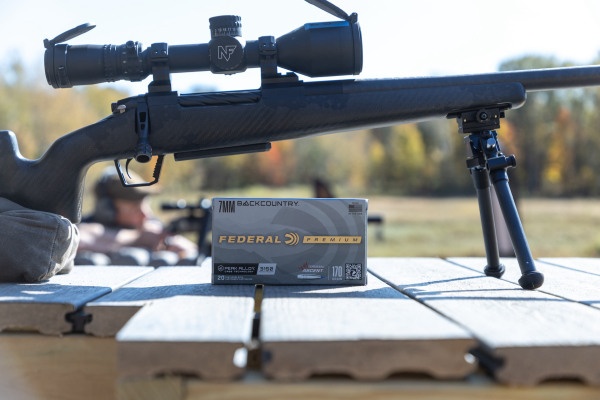
The 7mm Backcountry is available in a variety of rifles now, and that list will grow quickly.
What is the 7mm Backcountry? It’s the new king of speed for production 7mm rifle cartridges – for now.
"Welcome to the future of rifle cartridges," said Federal Director of Centerfire Rifle Ammunition, Mike Holm. "With our new 7mm Backcountry cartridge, hunters and shooters will experience true innovation. Those three numbers spotlight the three advantages of this new cartridge. "
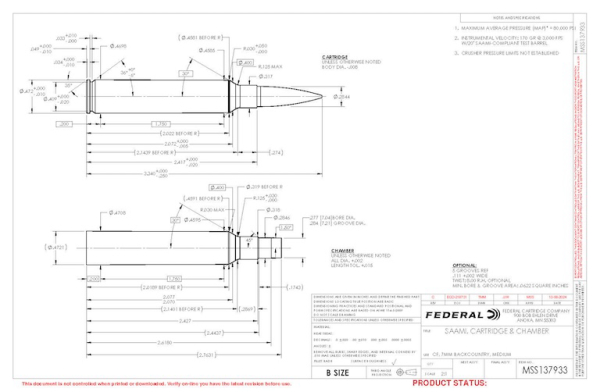
Federal submitted a complete submission package to the Sporting Arms and Ammunition Manufacturers’ Institute (SAAMI), which is an association of the nation’s leading manufacturers of firearms, ammunition and components. SAAMI was founded in 1926 at the request of the federal government.
How fast is it? Federal's 155-grain Terminal Ascent bullet, the lightest bullet Federal will initially offer in 7mm Backcountry, scoots out of a 24-inch barrel with a muzzle velocity of 3,300 fps. The cartridge is boosted by a new, patented Peak Alloy™ case technology, which provides magnum performance in a standard bolt-face rifle. Federal says it can achieve 3,000 feet-per-second (fps) with 170-grain bullets through 20-inch barrels.
Yes – 20-inch barrels. Yes, longer barrels will give you more velocity. Still, the whole point of this new cartridge is to give you all the ballistic horsepower you need at 20 inches, which is a real game-changer for today's hunters who prefer smaller, lighter, suppressed rifles for long-range big game hunting.
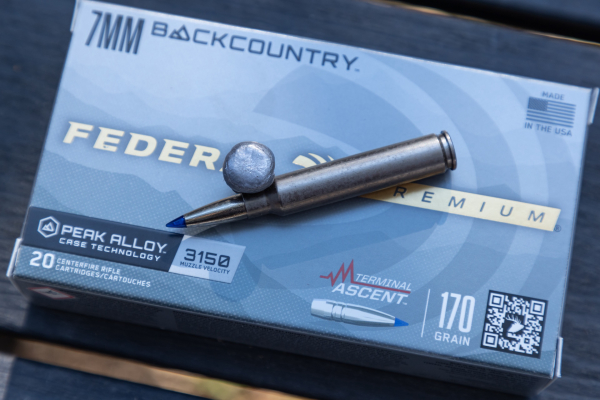
The Ultra-modern 7mm Backcountry pushes the 170-grain Terminal Ascent: 3,000 fps out of a 20-inch barrel.
"Our goal was to take the new case technology and design the ultimate, high-tech hunting cartridge that could handle loadings at a higher pressure," said Eric Miller, Federal's Centerfire Rifle Product Line Manager. "We also wanted it to operate in non-magnum, standard long actions to keep room for round capacity. The result is a non-magnum-looking cartridge with the same neck length as 7mm PRC, body taper and shoulder angle as 6.5 Creedmoor, and a cartridge size like 30-06 Springfield or 280 Ackley Improved. Yet it accepts heavy bullets with a long ogive."
To create the 7mm Backcountry, Federal didn't tweak an existing cartridge or use brass. They started from scratch, beginning with a metallurgy breakthrough in case design.
"The 7mm Backcountry is a result of six years of development," explained Brad Abramowski, Federal's Centerfire Rifle Ammunition Engineer. "Driven by the U.S. military's need for improved performance ammunition, we tested many materials at high pressures to ensure rifle function out of a one-piece case configuration for manufacturing efficiency and design reliability. Peak Alloy delivers everything we dreamed it would. It can be loaded at a maximum chamber pressure of 80,000 pounds per square inch (psi) and achieve 3,000 fps velocities with 170-grain class bullets out of 20-inch barrels.”
When developing the cartridge, Federal engineers developed testing to confirm safety when loading high-strength steel cases at 80,000 psi.
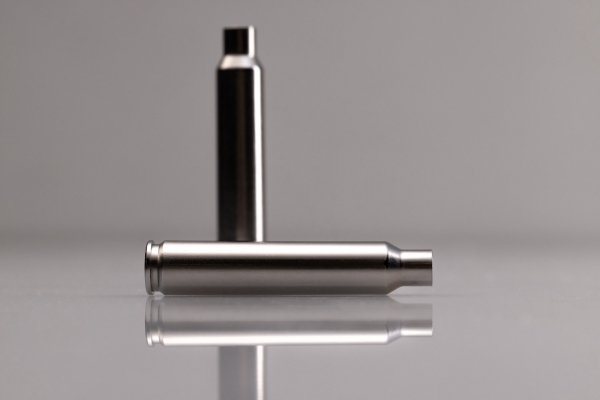
The Peak Alloy case can be loaded at a maximum chamber pressure of 80,000 pounds per square inch (psi).
"The results showed that brass cases loaded at pressures normal for brass cases created similar stress as high-strength steel alloy cases loaded at significantly higher chamber pressures," continued Abramowski. "Peak Alloy allows Federal to safely increase chamber pressures far beyond the limits of brass case ammunition. Additionally, Peak Alloy cases help increase muzzle velocity without a proportionate increase in felt recoil, which is a bonus."
What does that mean for you? You get magnum performance (think super high speeds and flat trajectories) without needing a magnum (heavier, longer, more cumbersome) rifle. You also experience less recoil than you'd expect for the power it delivers, with the folks at Federal telling us it kicks about the same as the 7 PRC.
A Ballistic Gift to Shorter Barrels and Suppressors
Federal knows what we all do – today's hunters favor shorter, more compact suppressed rifles to hunt all-range big-game.
"We acknowledge that hunters are moving away from magnum cartridges in long barrels to short, light, compact rifles with suppressors," said Holm. "And that move makes sense. Shorter-barreled firearms make everything easier when traveling with UTVs or other vehicles, hiking in a thick forest setting, maneuvering in hunting blinds, and you name it. However, shooters lose velocity when barrels are shortened, so there is a trade-off. Innovation was needed to deliver the advantages of hunting with shorter barrels while maintaining high velocities for flatter-shooting trajectory and projectile energy."
The downside with most cartridges? You lose velocity when you cut the barrel length. But Federal's 7mm Backcountry compensates for that ahead of time. Even a 20-inch barrel pushes a 170-grain Terminal Ascent bullet to 3,000 feet per second (fps), unheard of in a non-magnum cartridge. Less is more regarding barrel length for maneuvering through the woods, climbing into tight blinds, or ensuring your suppressed rifle doesn't carry like a shovel —while still delivering serious long-range big game performance.
Heavy Bullets with High BCs for Big Performance
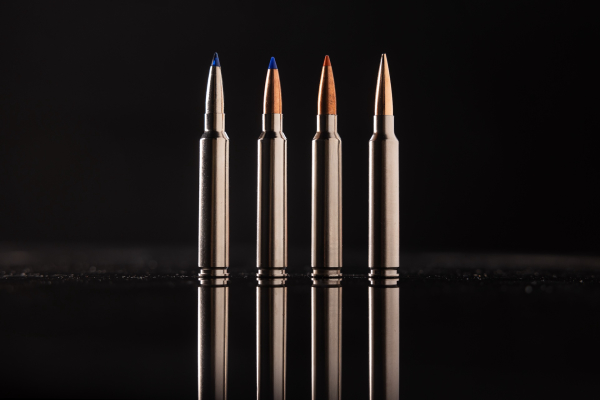
Federal’s 7mm Backcountry gives hunters a new cartridge built from the ground up thanks to an all-new case material which enables Federal to load the cartridge at a maximum chamber pressure of 80,000 pounds per square inch (psi).
As Hornady did with the wildly successful 7mm PRC, Federal optimized their new cartridge for heavy, long-range bullets, and these heavy-for-caliber projectiles have impressive ballistic coefficients (B.Cs). Why does B.C. matter? Higher B.C. bullets are more aerodynamic, so they cut through the air better, retain energy longer, and drop less over distance. For example, the 170-grain Terminal Ascent has a G1 BC of 0.645, perfect for taking down big game at long range. If you're into extreme long-range accuracy, the 195-grain Berger Elite Hunter boasts an insane BC of 0.755.
7mm Backcountry Versus 7mm PRC
Performance: Velocity
One of the standout features of the 7mm Backcountry is its velocity, thanks to Federal's innovative Peak Alloy™ case technology. This allows the cartridge to handle higher chamber pressures, pushing heavy bullets faster through shorter barrels.
Here's how the numbers compare:
7mm Backcountry (20-inch barrel)
170-grain Terminal Ascent: 3,000 fps
195-grain Berger Elite Hunter: 2,850 fps
7mm PRC (20-inch barrel)
Same 170-grain bullet: 2,850 fps
195-grain Berger: 2,750 fps
That extra 150 fps from the 7mm Backcountry matters to the speed junkies because it gives you a real edge in terms of flatter trajectories and increased downrange energy—key advantages for long-distance shots. If you're hunting with a suppressor on a shorter-barrel rifle, you're not losing nearly as much speed as you would with the 7mm PRC, the 7mm Remington Magnum, or the 280 Ackley Improved, or – you get my point.
Case Design and Pressure
The secret behind the Backcountry's speed lies in its Peak Alloy™ steel case. Unlike the traditional brass case used in 7mm PRC, this high-strength alloy allows Federal to push chamber pressures to an impressive 80,000 PSI—well beyond the limits of brass. It's an apples-to-oranges case design discussion now.
7mm PRC
It uses standard brass cases and operates at lower pressures (approximately 65,000 PSI), which limits its velocity potential, especially through shorter barrels.
7mm Backcountry
Thanks to Peak Alloy, it safely handles higher pressures without compromising rifle function or increasing felt recoil.
Barrel Length Advantage
Shorter barrels are trending among hunters (welcome to my world), especially those using suppressors. Why? Shorter barrels mean lighter rifles, faster handling, and easier suppressor management – a 24-inch magnum cartridge barrel with a six-inch suppressor attached to the end of it might be a ballistic beauty; still, it's a nightmare to carry, shoot, and maneuver on hunts that can be physically challenging on their own.
This is where the 7mm Backcountry shines.
How?
A 20-inch barrel 7mm Backcountry delivers magnum-level performance, maintaining a flat trajectory and high energy. The 7mm PRC, while still excellent, loses more velocity when you move to shorter barrels. To fully maximize its potential, the 7mm PRC typically requires a 24-inch barrel, which isn't always practical in the field.
Bullet Options and Ballistic Coefficients (BC)
Both cartridges excel with heavy bullets and high ballistic coefficients, which is ideal for long-range shooting. However, the 7mm Backcountry achieves higher speeds with the same bullets:
7mm Backcountry
• 170-grain Terminal Ascent (BC: 0.645)
• 195-grain Berger Elite Hunter (BC: 0.755)
7mm PRC
• 170-grain bullet: Slightly slower velocities (~2,850 fps).
The 7mm Backcountry's speed advantage means these bullets maintain more energy and better trajectory for longer distances than many other cartridges available to today's hunters.
Recoil and Rifle Compatibility
Both cartridges offer impressive performance with manageable recoil, but the 7mm Backcountry has an edge because of its higher efficiency and pressure design. Despite its magnum-like speeds, perceived recoil remains comparable to non-magnum options.
The 7mm Backcountry also fits into standard long actions, making it a great choice for hunters who want increased magazine capacity without requiring a magnum bolt face.
Which One Should You Choose?
I don't own either. My 7mm battery consists of a suddenly pedestrian 7mm Remington Magnum, a 275 Rigby that seems to kill off reputation alone, and a 7 mm-08 Remington which I used to bag my first black bear and bull moose. The 7 PRC and the 7mm Backcountry are ballistically better cartridges than all.
All this being said -
Choose the 7mm Backcountry if you want magnum-level performance in a shorter barrel, especially with a suppressor. It's the fastest production 7mm cartridge on the market, designed for today's modern hunting trends.
Choose 7mm PRC if you prefer a proven, brass-cased cartridge and are willing to use a longer barrel for its full performance.
In short, Federal's 7mm Backcountry pushes the boundaries of what a non-magnum cartridge can achieve. It delivers faster speeds, flatter trajectories, and superior performance from shorter-barreled rifles—giving hunters a modern, practical edge over the 7mm PRC. If you're looking for the future of rifle cartridges, this might be it.
OK, so you made your choice and let’s say its Federal’s new .284 caliber hot rod. Who chambers for it? At launch, the following gun companies will be introducing rifles in 7mm Backcountry: AllTerra Arms, Christensen Arms, Fierce Arms, Geissele Automatics, Gunwerks, Horizon Firearms, Proof Research, Pure Precision, Savage Arms, Seekins Precision, and Weatherby.
The firearms list is subject to change—check back to https://federalpremium.com/backcountry.html for updates on the latest gun offerings.
The Bottom Line & Why The 7mm Backcountry Matters
Federal's 7mm Backcountry is more than just a faster 7mm cartridge. It's a more advanced cartridge design, especially regarding its materials. I suspect that the Peak Alloy breakthrough, more than anything else, will prove to be Federal's biggest win here and reset the ballistic bar on what a "standard cartridge" can do.
Learn more at: www.federalpremium.com
– Jay Pinsky, Editor of The Hunting Wire & The Archery Wire